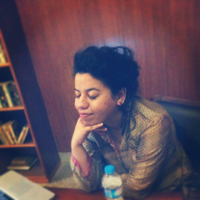More about Ploughing in Nevers
- All
- Info
- Shop

Contributor
Though you wouldn’t guess it from Rosa Bonheur’s peaceful countryside scene, this was painted at the dawn of the farmer’s doom.
Off the farm and into the factory, folks! It was the time of industrialization, of scientific knowledge, of Karl Marx! Of Gustave Courbet painting guys laboring away in the fields, barely making ends meet while the bourgeoisie partied it up. It was a time of hard fact and reason, not agriculture and cows! And artists were gettin’ real with these harsh truths. Then there was Rosa Bonheur. She sort of kept it real…but preferred to paint bovines hard at work instead of their sweaty human overlords.
Bonheur’s Ploughing in the Nevers is an 8-foot-wide wonder that shows the charms of country livin’. The idyllic scene was inspired by a book called The Devil’s Pond, written by a female author who Bonheur looked up to. The novel harkened back to the simplicity of rural life – lost in the maddening midst of industrialized Europe. It’s a thought every urbanite has at one point or another (generally while sardined into a crowded city bus): “Maybe I’ll move to the country and make cheese…”
But Bonheur actually did it. To get back to nature, she abandoned the overpopulated Paris and moved to a quieter, rural setting near Barbizon, with her “companion”, (if you gets my drift…) Nathalie Micas. And the move inspired her. Bonheur ‘s love of animals is clear in the way she expertly paints these hefty bulls ploughing in a somewhat majestic manner.
She’s not really getting all the unbecoming qualities of farm life across, though. Where’s the dirt, the sweat, the crap? You don’t sense that signature cocktail of bovine odor, when unwashed beast meets manure. She’s romanticized rustic life and ignored the gritty, stinky reality. Maybe that's why it received so much critical acclaim. City folk don't want to know what happens out there in the sticks. But in the end, it's just not real enough for a Realist painter. Sorry, Rosa. I know you really tried.
Featured Content
Here is what Wikipedia says about Ploughing in the Nivernais
Ploughing in the Nivernais (French: Labourage nivernais), also known as Oxen ploughing in Nevers or Plowing in Nivernais, is an 1849 painting by French artist Rosa Bonheur. It depicts two teams of oxen ploughing the land, and expresses deep commitment to the land; it may have been inspired by the opening scene of George Sand's 1846 novel La Mare au Diable. Commissioned by the government and winner of a First Medal at the Salon of 1849, today it is held in the Musée d'Orsay in Paris.
Check out the full Wikipedia article about Ploughing in the Nivernais














